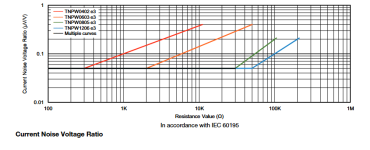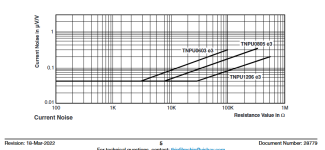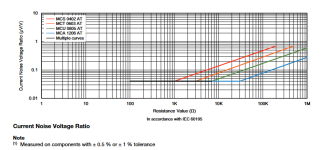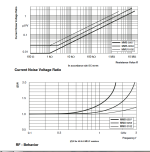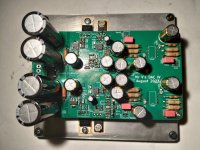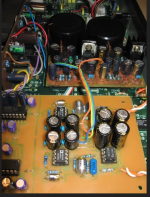Of course, everything depends on other components, speakers, amplifier, cables,... but generally speaking, a DAC must be neutral to be considered to have hi-end performance. If a system cannot reproduce sound from such a DAC, then the culprit should not be the DAC, but the system.I tried AD811 with TDA1540 and TDA1541A only, Not with other DAC types 🙂
Sorry I didn't wrote this, I should, because i dont want to speak in general?
.
And It depend on speakers as contact point... If they are Higher eff. and some type of horn with directivity as the factor,
too fast op can be "harsh", in opposite to other standard OPs, and with HF filter, that can be rather "mellow" or "chewing gum"... IMHO.
Best fit are Ge or Tube design... 🙂
I went through a very good school when, by improving one part of the chain you discover shortcomings in another part of the chain that you were convinced was working perfectly. I had the most problems with tubes that like to color the sound and it took me a long time to understand that it is difficult to make a neutral DAC with tubes.
That is why I consider the AD811 an ideal candidate for I/V if I compare it with other solutions, especially tubes that require much more complicated solutions to even come close to the AD811 .
btw; 15 years ago I tested the AD811 and TDA1541 on Pass amplifiers, ZEN and ALEPH3 and it sounded great to me then, but I made the mistake of adding an HF filter and buffer (with a Signetics NE5532) which hid the good performance of the AD811.
"Another thing that makes MELF better than classic SMD resistors is lower noise"
I think it is not true. They have some defults like still that helocoidal on substrate. More capacitive too.
MELF carbon can be handy... more choice than is smd flat package. There are some good higher Wattage flat smd nowadays. Idon't think it is the noise thing with the tantalum. Tantalum soft things, handy when some ic are very clear or too much on the sunligth side of sound. TDA1541 or AD1865 maigthnot profit of it, but of course proof in the pudding !
Maybe CFAs op amps are just easy to use for the task for some reason like low Z at invert and low impedance sensivity at the same input pin, but anyway not the best in the audio range and not the quietest both in voltage noise and of course in current noise at input.
45°C is a very good result with 15V with that op amp.
I think it is not true. They have some defults like still that helocoidal on substrate. More capacitive too.
MELF carbon can be handy... more choice than is smd flat package. There are some good higher Wattage flat smd nowadays. Idon't think it is the noise thing with the tantalum. Tantalum soft things, handy when some ic are very clear or too much on the sunligth side of sound. TDA1541 or AD1865 maigthnot profit of it, but of course proof in the pudding !
Maybe CFAs op amps are just easy to use for the task for some reason like low Z at invert and low impedance sensivity at the same input pin, but anyway not the best in the audio range and not the quietest both in voltage noise and of course in current noise at input.
45°C is a very good result with 15V with that op amp.
Last edited:
Zoran,
I hhave been looking at ADEL2020, seems less good than the AD811 everywhere : higher Z, worse settling time...
But maybe needs less Z at input to prevent osci because of that (or at least permit a less intrusive filtering at input ? AD8011 seems a better bet. But indeed too much cards to try.
If now we can source Ge transistors, I am lost, I even can not source old Tosiba BJT, ahaha ! And tubes are expensive or NLA.
Damned snobish hobby ! 😕
I still have though two canned BUF634 !
I hhave been looking at ADEL2020, seems less good than the AD811 everywhere : higher Z, worse settling time...
But maybe needs less Z at input to prevent osci because of that (or at least permit a less intrusive filtering at input ? AD8011 seems a better bet. But indeed too much cards to try.
If now we can source Ge transistors, I am lost, I even can not source old Tosiba BJT, ahaha ! And tubes are expensive or NLA.
Damned snobish hobby ! 😕
I still have though two canned BUF634 !
It is hard to obtain - unused. In equipment they used without any heatsink, so they are "exausted by high temperature".AD8011 seems a better bet.
.
Take a look at the LH0002 or LH0063 inside configuration. They are high speed, high current and CFA topology input stages. And open structure to configure on different ways via separated pins.
But also maybe a harder than AD811 to obtain.
Actually I took the peak now on ebay and they are (not Chinese) around LH0002 is 20usd piece, LH0063 40usd. National and Calogic.
.
Last edited:
I didn't write, nor did any of those who use it, that we were dissatisfied with the sound of the AD811, so I don't know why there's such a big offtopic about non-available op amps.
If you think the AD811 is no good, feel free to open your own topic, discuss, solder, test, all options are open to you 😉 .I want everything I do to be available to everyone, so only Mouser or Digikey come into consideration, everything else is out.
If you think the AD811 is no good, feel free to open your own topic, discuss, solder, test, all options are open to you 😉 .I want everything I do to be available to everyone, so only Mouser or Digikey come into consideration, everything else is out.
Probably can be done, but they dont have separated pins for syplying output stage... 🙁I still have though two canned BUF634 !
But it can be done by adding Current limiting modules and other additional discrete circuit...
Is anyone having a couple of spare PCBs as per Grunf's maybe?
I'd like to get there in the coming new year to this AD811 balanced IV stage, I'll need to move to a fully balanced preamp first.. and planning it will take place of my dddac 1794 tube output stage as I cannot squeeze the tube stage in the dddac case (well probably I could but it is not currently balanced..).
I'd like to get there in the coming new year to this AD811 balanced IV stage, I'll need to move to a fully balanced preamp first.. and planning it will take place of my dddac 1794 tube output stage as I cannot squeeze the tube stage in the dddac case (well probably I could but it is not currently balanced..).
This is for those who think MELF resistors are crap. The graphs are from Vishay DSs, classic thin film flat chip resistors. They all have higher noise than regular Vishay MELF.
Attachments
No it is good. Sorry for contributing to slight offtopic (few posts only)I didn't write, nor did any of those who use it, that we were dissatisfied with the sound of the AD811, so I don't know why there's such a big offtopic about non-available op amps.
If you think the AD811 is no good, feel free to open your own topic, discuss, solder, test, all options are open to you 😉 .I want everything I do to be available to everyone, so only Mouser or Digikey come into consideration, everything else is out.
And Yes they are available in DIP 🙂
Price is OK too.
.
https://eu.mouser.com/ProductDetail/Analog-Devices/AD811ANZ?qs=/tpEQrCGXCwyaTcANUKIlg==
.
https://www.digikey.com/en/products/detail/analog-devices-inc/AD811ANZ/671056
.
https://www.digikey.com/en/products/detail/analog-devices-inc/AD811AN/611545
.
And there is a heatsink for DIP8 too. Has to be bigger than standard. Probably custom made.
Last edited:
Are you thinking of Vunce's PCB?Is anyone having a couple of spare PCBs as per Grunf's maybe?
I'd like to get there in the coming new year to this AD811 balanced IV stage, I'll need to move to a fully balanced preamp first.. and planning it will take place of my dddac 1794 tube output stage as I cannot squeeze the tube stage in the dddac case (well probably I could but it is not currently balanced..).
We are on the same path, and I also plan to put my PCM1794 into operation this year. The PCB with the PCM1794 will be mine so I can place small shunt regulators right next to them. I'm just still thinking whether to put the four AD811s on the same PCB or separately so I can do tests.
We know about all this, Vunce made the PCB and BOM for the order from Mouser.And Yes they are available in DIP 🙂
Price is OK too.
.
https://eu.mouser.com/ProductDetail/Analog-Devices/AD811ANZ?qs=/tpEQrCGXCwyaTcANUKIlg==
.
https://www.digikey.com/en/products/detail/analog-devices-inc/AD811ANZ/671056
.
https://www.digikey.com/en/products/detail/analog-devices-inc/AD811AN/611545
.
And there is a heatsink for DIP8 too. Has to be bigger than standard. Probably custom made.
Now we need to find someone willing to make a new PCB that will include minor improvements to Walt's regulators and replace the RN60 with the PTN or PNM series.
Attachments
Space on the PCB for bigger heatsink is crucial.a new PCB
And,
maybe more part places for decoupling Cs
(47uF-330uF low Ri)+100nF+10nF+1nf+100pF -> each PS Pin
Grunf, as I am the who you talked
first a reminder : "
So all op amps as discretes.
Second, Thhs is you that said MILF is better than chip resistor not me who said MELF is crap (but sligthy less good nowadays, more a reflex of old diyers we are), this is an old thing, things have evolved and chip resistor can handle the same wattage nowadays with no more noise . And for the thing you talk about around the opa amp (with your limited pcb possibilities as you can not at home choose the distance of ground) resistors, it matters. I didn't invent what I wrote about the architectire of MELF. For what you care chip film resistors and caps are better : Acrylic cap, non inductive silver mica, or low esl Class I ceramic of 0805 max as Cfb; as you said : non inductoive resistor in serie with the signal (input and Rfb) to playy with any high BW/highish Slewrate op amps.
I never said it is crap I said film chip is better nowadays and it rigth where it belong as you talk about layout for stray capacitance reasons ! Simple as that.
Anyway AD811 seems having the best spec but the are better new process also in CFA that help too. And It willl be clever to say half if not more of the result is due to the WJ super reg and not only the AD811. As far I know people jumped on that without tried it with other op amps needing good PSRR or CMRR lile the op861 (remember : open loop, guess why it is important as I/V). It is not hard to understand that AD811 is good sound but is not the best topology for I/V because a CFA is ultimatly made for having good noise at high frequency (not also alas where it matters for us, whatever any Super Reg used)
And yes it is obvious whhy any chip film resistor and cap will be better for the op amps at input and feedback ! It is useless to compare RN60 THT with a tantalum chip film resistor. I don't say tantalum and non inductive is not whished, but it is faire to compare apples with apples. There are good Vishay
@Zoran.
Yup, ad8011 is low volt 12v singlle rail or 6v max rail to rail. Same price than AD811 at Mouser. I hesitated with the BJT emitter input LT1028, but the Slew rate is too low I think 15V iirc. LT1465 ?
ADA4898 that has poor Slew rate but very good input linearity, more modern process than those olld CFA with their inherant low high current noise for DAC i/V ? There is a chance a composite with the AD8111 as buffer canle driver with something else before could be promising too. 9631 + AD711, or op828 + AD711 for instance, maybe even LT1028 which seems stable at G+1, then AD711 or any good CFA.
Or something discrete + any op amp buffer?
What do you think for a classic BJT input schematic with base input for good noise, but with the choice of very low Rbb BJT like some Zetex that have few ohms ? Feasible with the 2K source of the AD1862 ? I believe but I am not sure: it is not advised to use low Rbb input BJT whith high impedance ssource ? with a class A output mirror as buffer, Best of the two worlds ?
Okay JFETs have lowisch input noise, but what Thorsten adressed to us in the other dead thread alerted about the use of JFET here... Humm opA1655/1656 still one of the best for the AD1862 : CMOS, high current...
Sergios Santos I/V is very low noise but Bohrok member didn't reported better sound than th eusual best op amps or discrete current mirror (not worse either)
first a reminder : "
AD811 as I/V stage for current DACs (and test some other opamps including Burson Audio opamps as I/V)"
So all op amps as discretes.
Second, Thhs is you that said MILF is better than chip resistor not me who said MELF is crap (but sligthy less good nowadays, more a reflex of old diyers we are), this is an old thing, things have evolved and chip resistor can handle the same wattage nowadays with no more noise . And for the thing you talk about around the opa amp (with your limited pcb possibilities as you can not at home choose the distance of ground) resistors, it matters. I didn't invent what I wrote about the architectire of MELF. For what you care chip film resistors and caps are better : Acrylic cap, non inductive silver mica, or low esl Class I ceramic of 0805 max as Cfb; as you said : non inductoive resistor in serie with the signal (input and Rfb) to playy with any high BW/highish Slewrate op amps.
I never said it is crap I said film chip is better nowadays and it rigth where it belong as you talk about layout for stray capacitance reasons ! Simple as that.
Anyway AD811 seems having the best spec but the are better new process also in CFA that help too. And It willl be clever to say half if not more of the result is due to the WJ super reg and not only the AD811. As far I know people jumped on that without tried it with other op amps needing good PSRR or CMRR lile the op861 (remember : open loop, guess why it is important as I/V). It is not hard to understand that AD811 is good sound but is not the best topology for I/V because a CFA is ultimatly made for having good noise at high frequency (not also alas where it matters for us, whatever any Super Reg used)
And yes it is obvious whhy any chip film resistor and cap will be better for the op amps at input and feedback ! It is useless to compare RN60 THT with a tantalum chip film resistor. I don't say tantalum and non inductive is not whished, but it is faire to compare apples with apples. There are good Vishay
@Zoran.
Yup, ad8011 is low volt 12v singlle rail or 6v max rail to rail. Same price than AD811 at Mouser. I hesitated with the BJT emitter input LT1028, but the Slew rate is too low I think 15V iirc. LT1465 ?
ADA4898 that has poor Slew rate but very good input linearity, more modern process than those olld CFA with their inherant low high current noise for DAC i/V ? There is a chance a composite with the AD8111 as buffer canle driver with something else before could be promising too. 9631 + AD711, or op828 + AD711 for instance, maybe even LT1028 which seems stable at G+1, then AD711 or any good CFA.
Or something discrete + any op amp buffer?
What do you think for a classic BJT input schematic with base input for good noise, but with the choice of very low Rbb BJT like some Zetex that have few ohms ? Feasible with the 2K source of the AD1862 ? I believe but I am not sure: it is not advised to use low Rbb input BJT whith high impedance ssource ? with a class A output mirror as buffer, Best of the two worlds ?
Okay JFETs have lowisch input noise, but what Thorsten adressed to us in the other dead thread alerted about the use of JFET here... Humm opA1655/1656 still one of the best for the AD1862 : CMOS, high current...
Sergios Santos I/V is very low noise but Bohrok member didn't reported better sound than th eusual best op amps or discrete current mirror (not worse either)
We know about all this, Vunce made the PCB and BOM for the order from Mouser.
Now we need to find someone willing to make a new PCB that will include minor improvements to Walt's regulators and replace the RN60 with the PTN or PNM series.
Send me the Gerber I can certainly improve what you ask and some parts of the pcb layout. What is around the smd op amp of the super reg seems very okay layout.
You've been on my ignore list for a long time, I guess you figured it out yourself. I've already written before that if you think the AD811 is no good, feel free to open your own topic, discuss, solder, test, all options are open to you 😉. I see, that AD811 bothers you so much, so why don't you try it and prove to us the opposite.Grunf, as I am the who you talked
first a reminder : "
AD811 as I/V stage for current DACs (and test some other opamps including Burson Audio opamps as I/V)"
So all op amps as discretes.
Second, Thhs is you that said MILF is better than chip resistor not me who said MELF is crap (but sligthy less good nowadays, more a reflex of old diyers we are), this is an old thing, things have evolved and chip resistor can handle the same wattage nowadays with no more noise . And for the thing you talk about around the opa amp (with your limited pcb possibilities as you can not at home choose the distance of ground) resistors, it matters. I didn't invent what I wrote about the architectire of MELF. For what you care chip film resistors and caps are better : Acrylic cap, non inductive silver mica, or low esl Class I ceramic of 0805 max as Cfb; as you said : non inductoive resistor in serie with the signal (input and Rfb) to playy with any high BW/highish Slewrate op amps.
I never said it is crap I said film chip is better nowadays and it rigth where it belong as you talk about layout for stray capacitance reasons ! Simple as that.
Anyway AD811 seems having the best spec but the are better new process also in CFA that help too. And It willl be clever to say half if not more of the result is due to the WJ super reg and not only the AD811. As far I know people jumped on that without tried it with other op amps needing good PSRR or CMRR lile the op861 (remember : open loop, guess why it is important as I/V). It is not hard to understand that AD811 is good sound but is not the best topology for I/V because a CFA is ultimatly made for having good noise at high frequency (not also alas where it matters for us, whatever any Super Reg used)
And yes it is obvious whhy any chip film resistor and cap will be better for the op amps at input and feedback ! It is useless to compare RN60 THT with a tantalum chip film resistor. I don't say tantalum and non inductive is not whished, but it is faire to compare apples with apples. There are good Vishay
@Zoran.
Yup, ad8011 is low volt 12v singlle rail or 6v max rail to rail. Same price than AD811 at Mouser. I hesitated with the BJT emitter input LT1028, but the Slew rate is too low I think 15V iirc. LT1465 ?
ADA4898 that has poor Slew rate but very good input linearity, more modern process than those olld CFA with their inherant low high current noise for DAC i/V ? There is a chance a composite with the AD8111 as buffer canle driver with something else before could be promising too. 9631 + AD711, or op828 + AD711 for instance, maybe even LT1028 which seems stable at G+1, then AD711 or any good CFA.
Or something discrete + any op amp buffer?
What do you think for a classic BJT input schematic with base input for good noise, but with the choice of very low Rbb BJT like some Zetex that have few ohms ? Feasible with the 2K source of the AD1862 ? I believe but I am not sure: it is not advised to use low Rbb input BJT whith high impedance ssource ? with a class A output mirror as buffer, Best of the two worlds ?
Okay JFETs have lowisch input noise, but what Thorsten adressed to us in the other dead thread alerted about the use of JFET here... Humm opA1655/1656 still one of the best for the AD1862 : CMOS, high current...
Sergios Santos I/V is very low noise but Bohrok member didn't reported better sound than th eusual best op amps or discrete current mirror (not worse either)
As for helping with the PCB, why bother when you hate the AD811 so much, there's no point in that.
I think we've ended the discussion with this 😉 .
I have the original article from Audio Amateur 2/92 when Gary Galo, Walt Jung and Hampton Childress modified the Philips DAC 960, Walt recently sent it to me, very good reading. As part of that article there was also a short review with measurements from Walt Jung on the AD811 itself and its application with the TDA1541. That short article led me to the AD811 a long time ago and for this today I have Walt's full support so there is no lack of knowledge.
Attachments
A good electrolyte and a high-quality SMD COG are quite enough for decoupling, it is important that the SMD is right up to the power supply pins.Space on the PCB for bigger heatsink is crucial.
And,
maybe more part places for decoupling Cs
(47uF-330uF low Ri)+100nF+10nF+1nf+100pF -> each PS Pin
🙂
I am not sure to test an opa amp which best engineers audiophils said it is not the good choice. It doesn't say it is sounding bad as I said (we know why btw) but more there are surely better when you beginn indeed to look at the supply as well.
that is because you're on my ignore list too, firstly because your big afirmations about EI ECC88 and now AD811 w/o real evidences because of the confusion between layout, regulators, etc : not very logical approach. For me it is nearer of messianism than science. That's why I care. It is faire to correct some wrong inputs.You've been on my ignore list for a long time, I guess you figured it out yourself. I've already written before that if you think the AD811 is no good, feel free to open your own topic, discuss, solder, test, all options are open to you 😉. I see, that AD811 bothers you so much, so why don't you try it and prove to us the opposite.
As for helping with the PCB, why bother when you hate the AD811 so much, there's no point in that.
I think we've ended the discussion with this 😉 .
I am not sure to test an opa amp which best engineers audiophils said it is not the good choice. It doesn't say it is sounding bad as I said (we know why btw) but more there are surely better when you beginn indeed to look at the supply as well.
A good electrolyte and a high-quality SMD COG are quite enough for decoupling, it is important that the SMD is right up to the power supply pins.
False again, It is ESL that matters. COG I is rigth because they are not noise generator by flexing behavior on the pcb. Sometimes too much low value can be direct pass to noise back towards the input via PS decoupling throut the output through CfB.
Small form factor is then what matters.
Anyway I have made a proposition to enhance the Vunce PCB as you want. I think it is good sympathetic enough for the communauty if Vunce have no time. So I don't hate it, I don't like its default for the task but I said it as some qualities too like its low independance to capacitance at the inverted pin and its low Z (which is beaten by opa861, that has good advantage to be open loop for that tak).
So for the electrolythic, first choose the least space between leads : 2 to 2.5 mm and put the gnd of the negative supply tht ground the nearest to the output as possible if you use +/- op amps power supplied.
Last edited:
- Home
- Source & Line
- Digital Line Level
- AD811 as I/V stage for current DACs (and test some other opamps including Burson Audio opamps as I/V)
